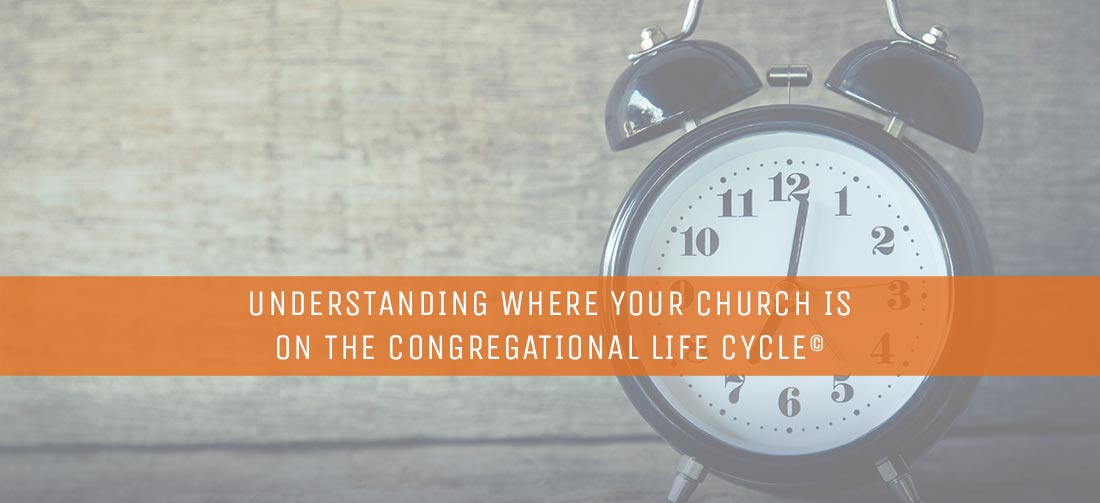Almost every time I speak about church decline and death, someone challenges my thesis. They tell me churches will not die, according to Jesus’ words in Matthew 16:18: “And I also say to you that you are Peter, and on this rock and I will build my church, and the gates of Hades will not overpower it.”
There are two major problems with the argument that churches will not close. First, Jesus is not referring to any one congregation in this passage; He is referring to the Universal Church. Second, churches are dying, lots of them—several thousand each year in America alone.
It is, therefore, helpful to see the life cycle of churches so we can at least understand visually where our church resides currently, and where it may be heading. I call this visual the Congregational Life Cycle ©.
This approach delineates six stages. Keep in mind that most churches are not totally focused on any one stage at any time. Rather, the Congregational Life Cycle demonstrates where a church is predominantly focused in its resources of time, money, and emotions.
Outward Focus
This is the beginning stage of most new churches. In the spirit of the Great Commission of Matthew 28:19 or Acts 1:8, the church focuses the majority of its resources reaching the community and having gospel conversations. The focus is on the “other” instead of the “us.”
Organization and Structure
A church without a healthy organization and structure is like a body without a skeleton. It cannot survive as an unstructured mass. It needs a clear polity. It needs a place to meet. It needs a healthy system of groups. It needs clearly defined leadership. It needs processes and procedures.
Integration and Assimilation
A congregation is better able to integrate and assimilate the congregants with a healthy organization and structure. The previous stage was more about the right structure. This stage is about integrating people into the structure.
Inverse Priorities
I also call this stage “the tail wagging the dog.” The previous two stages become ends instead of means. Members seek to hold onto the ministries, programs, processes, and styles where they are comfortable. Two phrases become common mantras in the church: “We’ve never done it that way before” and “We will not change.”
Decline
The church not only declines numerically; it declines in spirit and unity. The congregation often looks more like a spiritual country club doling perks and privileges, rather than a biblical church where all of the parts of the body are working in a self-sacrificial manner.
Death
The church closes its doors. In the past, death took years, even decades, to become a reality. Now it comes with surprising speed and unforgiving force.
What Now?
What are church leaders to do with this Congregational Life Cycle? First, determine where your church is on the cycle today. Where is your congregation expending the greatest level of resources?
Second, always seek to move to Outward Focus. Seek to expend your greatest resources being a true Great Commission church. Seek to reach your community with unadulterated love and grace-filled giving.
Even a church about to close its doors can move to the Outward Focus stage. The church can give its building and resources to a healthy congregation. It can become acquired by another church. It can become a church replant. Through its own death, it can give new life to another congregation.
But all churches should prayerfully move to the stage of Outward Focus, where the greatest level of resources are focused on reaching others and discipling them. That’s what the early church modeled.
And that’s what our church should model today.
Posted on January 3, 2018
With nearly 40 years of ministry experience, Thom Rainer has spent a lifetime committed to the growth and health of local churches across North America.
More from Thom





24 Comments
As a church design/builder and church realtor for 28 years, I seen a lot of churches thriving and dying. An interesting observation from a Baptist preacher that decades ago did his doctoral research on church growth. He observed generally that churches with infant baptism theology tended to survive multiple generations while the preacher centered adult baptism churches often thrived only two generations.
I try to encourage a dying church to find a way to pass the building on to a sympathetic growing young church that needs the building, or possibly a multi-site practice.
It is especially encouraging to work with thriving churches that are over a hundred years old. Continue to teach how to pull out of the death spiral!
thanks for adding me to your mailing list, I am neither a pastor or church leader. Just from where I am viewing Christianity , the biggest struggle I’m seeing within our church (it could be others as well) is the conflicts not necessarily with individuals per say but the lines that separate these individuals in regards to Grace, and Legalism, salvation and the loss of salvation,,; and within this dynamic, I see hesitation of the (laborers) going out to work for His harvest,, If growth and death both are measured by the numbers out in the field, then I guess, there are many local church families on life support. Not sure if this makes any sense, so, I will end with a thank you for your work in Christ,,
Thanks for joining us, David.
This was truly helpful to me. I currently serve in a church (not as Senior Pastor) and I’m having trouble helping them understand where they are and where we need to go. I would love to use Autopsy of a Deceased Church as a tool but how do you tell a Pastor “This church is dying?” Although I understand this, the implementation of it is difficult when you’re not the Pastor.
Marco –
Thank you. I did an entire podcast to answer that question:
https://thomrainer.com/2017/12/revitalization-second-chair-revitalize-replant-019/
I agree that churches are dying. One former church I served when I left had 260 people today they are at 100. Two local churches have closed their doors. Three churches I have had opportunity to speak at are at less than 50 people.
Thank you, Allen.
I find this and your other posts about the dying church to be an accurate description of church health here in the UK. I became acquainted with your work whilst staying with friends in Pierre SD last fall, when we were privileged to attend the Dakota Baptist Association Convention there.
Thanks for all you do.
Graham, Bedworth, England UK
Thank you for being a part of this community all the way from the UK, Graham.
Thank you for this important insight and visual. Having walked a few churches and pastors through an assessment of their location on the Congregational Life Cycle, I have also found George Bullards research and tutorials helpful – especially his graph on the various stages and “conditions” or signs of church Life/Death and Congregational Development.
Thank you, Doug.
Ditto to Tim’s heartfelt remarks… It’s beyond amazing that you effectively lead an international corporation with 5K employees yet still invest an immeasurable amount of time and energy into church planting and renewal. You and your team are a gift from God to pastors, laymen and churches around the world. Take good care of yourself we need you!
Larry –
You and Tim are great encouragers. I am beyond grateful that God is allowing me to interact with such leaders as you. People like you are among my greatest joys.
There are other reasons besides the usual “blame the church” reasons that churches may die.
I’ve spent my life following oil field booms and busts. Often healthy churches seem to spring up quickly but die just as quickly when the community (not the church) falls below a sustainable number. A church or two that are healthy and viable in a village of 200 may die quickly when the village becomes one of 13. But on the up side of that, several area villages may form a consolidated healthy church. Lacking other villages, church may die until the next boom.
And then there is the sad situation that should be a badge of honor. In those same boom towns I’ve seen healthy churches flourish in a basically healthy society. But let the society adopt the attitudes and morals of the lower living among the roughnecks and no healthy church can survive. By that I mean no church that continues to preach the necessities of repentance from sin and belief in Jesus for forgiveness. Churches that preach a watered down “Jesus loves you just as you are and will even celebrate your sin” may thrive, but not the Biblical ones.
So I would just add the thought there are circumstances where even the best church cannot survive, and circumstances where some sick churches SHOULD die. Better a town with no church than one full of only false teaching ones.
Thank you, Linda
People don’t believe that their church is capable of dying or is dead? Remind them of Jesus’ words to the Church of Sardis in Revelation 3:1, 2 “…I know thy works, that thou hast a name that thou livest, and art dead. Be watchful, and strengthen the things which remain, that are ready to die: for I have not found thy works perfect before God.” This is only one example from Scripture of a church that died. There are others.
Brother Rainer, I appreciate your ministry very, very much. Perhaps one day I can tell you how about the impact you have made on me, my church, and a church that I am helping to revitalize.
I am humbled by your words, Tim.
I am always blessed by your insight in condensed version. As a Pastor of a mid size healthy church for 22 Years my heart has beat to a constant theme “Let the Church Be Born Again!” Upward we focus on Him. Outward we focus on the lost. Inward we focus on renewal.
Bless you Thom. Keep up the insights!
You are kind and gracious, Joe. Blessings on your ministry and life as well.
My thought is that if churches die it is because they choose a course that leads to death; i.e., they choose to be inward focused and/or refuse to change unhealthy habits. Jesus does not choose for a local church to die.
A GREAT read is Henry and Richard Blackaby’s book Flickering Lamps, which biblically addresses declining and dying churches.
Thanks, Leonard.
My husband gave me the book, “Surprising Insights from the unchurched and proven ways to reach them”. I noticed the copyright is 2001. Is this research out of date ?
We are a declining church. My husband and I are layleaders and we were encouraged by your advice to pray for our church and continue to live out the Great Commission. Thank you for this blog!
Thanks, Bonnie. I have not updated that research, so I cannot attest to its validity today.